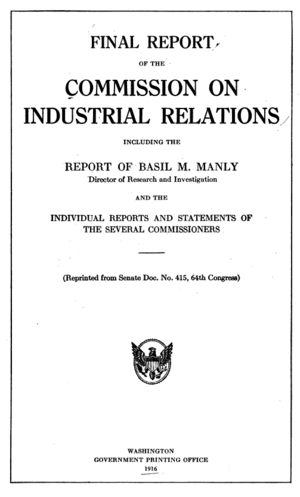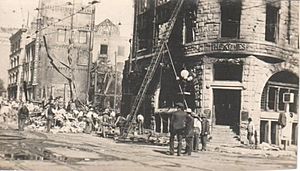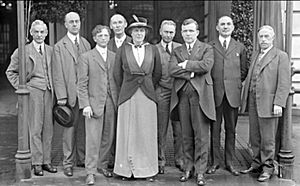Commission on Industrial Relations facts for kids
The Commission on Industrial Relations, also known as the Walsh Commission, was a special group created by the U.S. Congress. This happened on August 23, 1912. Its main job was to look closely at US labor law and working conditions across the United States.
The Commission studied how people worked in different industries between 1913 and 1915. Their final report was huge, filling eleven books in 1916. It included thousands of pages of stories from many people. These included famous lawyers like Clarence Darrow and Louis Brandeis, labor leaders like Mary Harris "Mother" Jones and William "Big Bill" Haywood, and many everyday workers. They also heard from powerful business leaders such as Henry Ford and Andrew Carnegie.
Contents
Why the Commission Was Formed
In 1910, a serious event happened that shocked the public. Two leaders of the Structural Ironworkers Union, known as the the McNamara Brothers, were involved in an explosion at the Los Angeles Times building. This tragic event caused many deaths.
Because of the strong public reaction, President William Howard Taft suggested creating a special committee. This committee would investigate industrial relations. Congress agreed, and the nine-person Commission on Industrial Relations was officially formed on April 23, 1912. Their findings were shared on April 23, 1915.
The idea for the Commission came from a petition given to President Taft on December 30, 1911. It was called "Petition to the President for a Federal Commission on Industrial Relations." Many important people signed it, including those from Survey magazine like Paul Underwood Kellogg.
Who Was on the Commission?
The Commission had nine members, called commissioners. The president chose them, and the U.S. Senate had to approve them. Most of them served for the entire time the Commission was active.
The first nine Commissioners were:
- Chairman Frank P. Walsh, a labor lawyer from Kansas City, Missouri
- James O'Connell, from the American Federation of Labor (A.F.L.)
- Austin B. Garretson, from the Order of Railway Conductors
- John Brown Lennon, also from the A.F.L.
- Frederic A. Delano, who was president of the Wabash Railroad and an uncle of Franklin D. Roosevelt
- Florence Jaffray Harriman, a social activist from New York
- Harris Weinstock, a businessman from California
- S. Thruston Ballard, a flour mill owner from Kentucky
Just before the Commission's final report, Commissioner Delano left. He was replaced by Richard Aishton, who was a vice-president of the Chicago & Northwestern Railroad.
The Commission also had staff members who helped with their work. These included John R. Commons, an expert in labor economics, and Luke Grant, a journalist.
What the Commission Investigated
The Commission's main jobs were to:
- Look into the general working conditions in major industries across the United States, including farming.
- Study how groups of employers and workers (like unions) grew.
- See how these groups affected the relationships between bosses and employees.
The Commission held 154 days of meetings to gather information. Frank P. Walsh, the chairman, made sure the Commission's work got a lot of public attention.
Here are some things the Commission found:
- Lumber workers in the Northwest worked ten hours a day and earned only twenty cents an hour.
- Many people in Pacific Coast cities struggled with seasonal unemployment, meaning they didn't have work all year.
- In California, farm workers labored in fields where temperatures reached 105 degrees. Growers often did not provide water in the fields.
- At one silk mill in Paterson, New Jersey, workers were fined fifty cents for talking and fifty cents for laughing while working.
The Commission also looked into several big strikes that happened during their investigation. These included:
- The Paterson, New Jersey, silk mill strike (1911–1913), led by the Industrial Workers of the World.
- The New York City garment workers strike (1909–1910).
- Conflicts between railroad workers and companies like Illinois Central (1911–1915).
- The Colorado Fuel and Iron Company strike, where the Ludlow Massacre occurred (1913–1914). This was a very sad and violent event.
Chairman Walsh even questioned John D. Rockefeller Jr., a very powerful businessman, about the Ludlow massacre. This questioning was very public and intense.
Historians noted that the Commission found that police and courts often supported employers. This led to workers sometimes taking matters into their own hands during strikes.
What the Commission Concluded
The Commissioners could not agree on everything, so they published three different final reports.
One report, mainly written by Commissioner Commons, was signed by five of the nine Commissioners. This report suggested creating fair labor boards to help solve problems. It did not see conflict between workers and bosses as something that would always happen.
Another report was signed by Chairman Walsh and Commissioners Lennon, O'Connell, and Garretson. This report was much stronger in its language. It called for "industrial democracy," meaning workers should have more say in their workplaces. It also suggested a "Single Tax" on land values.
This report described conditions on large farms, calling them "industrial feudalism." It said that these farms were often owned by very rich people who lived far away. It also noted that company towns (towns owned by a single company) felt like "feudalism," where the employer had almost complete control.
A separate statement by Commissioners Lennon and O'Connell said that strong trade unions (worker groups) were important. They believed that where workers were not organized, there was much unhappiness, low pay, and unfair treatment. They wrote that efforts to stop workers from organizing should not be allowed. They felt that if people had no say in their work conditions, it was like living under feudalism or slavery.
How the Commission Influenced the Future
Historians still discuss how much the Commission's reports affected U.S. politics.
Some historians, like Graham Adams, Jr., believe the Commission's work helped lead to important labor laws. An example is the Adamson Act, which set an eight-hour workday. They also think it influenced later labor laws during the New Deal era.
Historian David Montgomery said that the Commission was special because it focused on real problems between workers and employers. He believed its work led to new ideas for the Democratic party in 1916 and influenced how companies treated their workers in the 1920s.
However, other historians, like LaFayette Harter, argue that Congress mostly ignored the Commission's findings. George Brooks also suggested that the Commission might not have been as important as some other investigations in shaping major labor changes.
Images for kids







